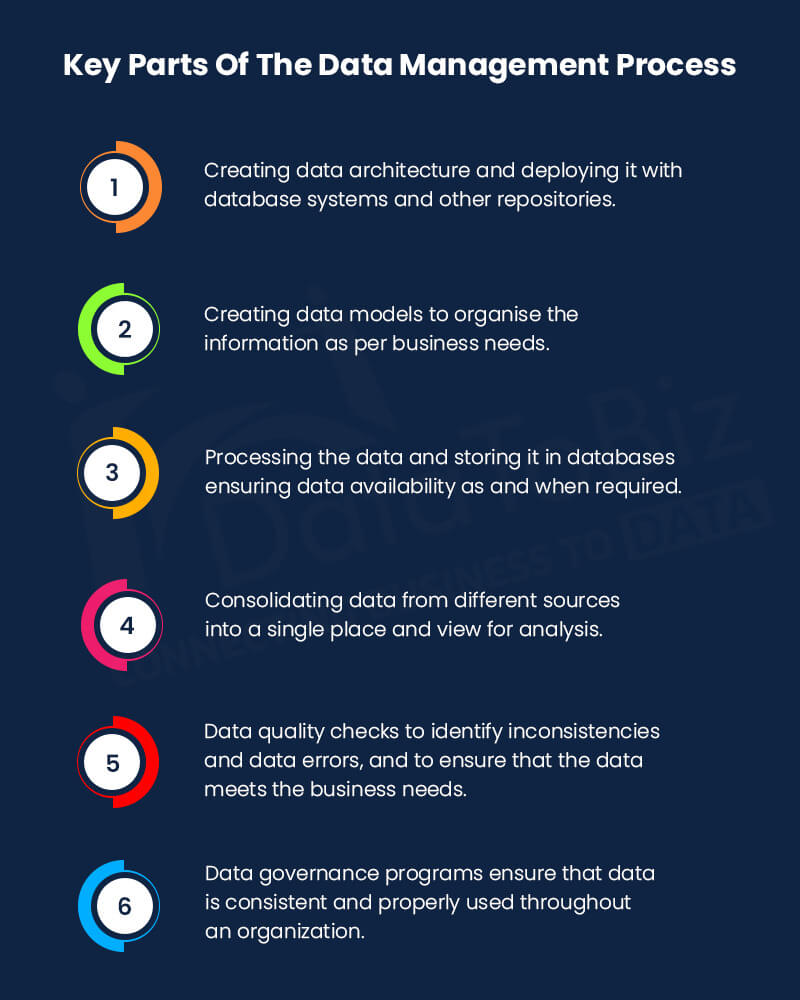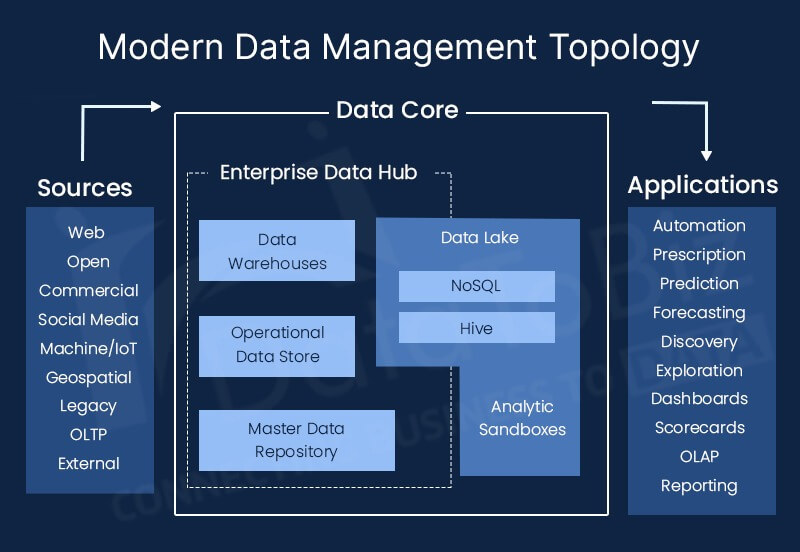Data is priceless in today’s world. Never before was it considered as essential to a business as it is in recent times. Whether it is easy to access real-time data or the availability of advanced technology to process and analyze this data, enterprises are trying to make the most of this precious raw material.
Data management in today’s world needs a modern approach to effectively handle the complex problems of dealing with multiple data formats.
Data in its original form is raw, unstructured, and comes in multiple formats. Data management is the process of collecting, sorting, arranging, and managing vast amounts of data to help businesses derive valuable insights from it. From data governance to data architecture and security, modern data management is a multifaceted discipline.
But following the modern data management approach is not easy, especially for enterprises that are used to traditional business methods. That’s where consulting companies take care of data management services and help SMEs unlock the full potential of data on their own.
In this blog, we’ll see how to adopt the modern data management approach in an enterprise. But before that, let’s read a little about data management, why it is necessary for every business, and what benefits an enterprise can get by investing in modern data management.
Data management is a combination of various functionalities that help enterprises use accurate and reliable data to derive insights that help in decision-making. An enterprise needs a comprehensive data management strategy if it wants to adopt the data-driven approach and rely on business intelligence tools to generate valuable reports.
The enterprise needs to establish policies and best practices to ensure that the data management strategy is aligned with the goals. The data management system includes a wide range of processes like-

Data management can be classified into the following types-
This is a process where all data sources lead to the same data center. A master database is updated and used to make all business-related decisions. A single, latest version of the database is used as a reliable source of data.
Security filters and applications are used at every level to ensure that the data in the database cannot be easily accessed or hacked by people without permission. It also safeguards the data from being deleted or modified by mistake.
Identifying and removing duplicates, eliminating inconsistencies, etc., are a part of data quality management. This is done when data is collected from all sources and stored in the database.
A data steward is a tool that is used to supervise and implement data policies across the enterprise. A data steward is also a person responsible for the same.
These are the set of laws framed by the top management to ensure proper use of data. It is a framework of rules and regulations which the data stewards implement in the business. A data governor is a person who supervises the data steward.
The process of storing vast amounts of data and using it for analytics is known as data warehousing. It can either be managed on-premises or on the cloud. Choosing the right data warehouse is crucial for a business to successfully utilize its data.
Collecting, cleaning, and processing huge amounts of data is known as big data. Managing raw, semi-structured, and structured data collected from multiple sources is called big data management. Traditional systems are not enough for big data management.
So how is modern data management different? It is nothing but an advanced approach where data is connected with the latest technology like artificial intelligence to get predictive insights, identify challenges and opportunities in the market, and help SMEs make faster and better decisions.

There are quite a few reasons for a business to invest in data management and ensure there are no glitches in the system. Something as basic as feeding wrong information can lead to disastrous results for the business. Enterprises hire big data consulting services to streamline their business processes and migrate from the traditional approach to the modern one. It makes the transitions easier and amplifies the results.
In short, the success of a modern enterprise depends on how effectively it can manage the huge amounts of data in this system.
Following a comprehensive step-by-step is essential if you want to build a modern data architecture in your business.
Whether it is cloud data analytics or on-premises services, the following are some of the benefits of following the modern data management approach in an enterprise.
The increasing cyberattacks have resulted in new and stringent data security policies. Unless businesses adhere to these regulations, they cannot be eligible to bid for government projects. Modern data management services include high-level data security and enable enterprises to use automated tools for data protection.
Digital transformation is a continuous process where the systems, tools, employees, and work environment has to be aligned to achieve the common goals. Modern data management makes it simpler for the management and employees to accept and adapt to the changes. This increases business efficiency and productivity.
There is no point if data scientists spend more than half of their time collecting and cleaning data. When will this data be analyzed? What about real-time data? Data strategy consulting services are the answer. Automating recurring tasks, using AI-based technology, and investing in advanced software for data analytics will help enterprises optimize resources and increase returns.

Isn’t this what every enterprise wants? Imagine getting in-depth reports that are easy to understand. It will help employees and management choose the best way forward for the business. Being armed with accurate insights can make an enterprise a leader in the industry.
For an enterprise to get started with the modern database management approach, it needs to set up the basics and has a clear idea of the following-
The data management architecture used by many enterprises is a traditional model that’s decades old. Instead of replacing the entire setup, businesses have been adding new tools to the existing setup. This has created a complex mix of old and new that doesn’t deliver the kind of results an enterprise needs.
The traditional architecture doesn’t support big data analytics. And without big data technologies, SMEs cannot get predictive insights to make better decisions. Modern data architecture supports vast volumes of data and can deliver the results while being a cost-effective solution. It can handle diverse data types and process them with ease.
It empowers the enterprises with reliable and accurate insights to make the right decisions. The first step to follow the modern data management approach is to understand the data storage and processing requirements. Today’s data storage needs to accept unstructured, semi-structured, and structured data and allow diverse data analytical tools to be used on the data.
It’s important to know if the enterprise needs to invest in a data warehouse or opt for data lakes. The overall data architecture needs to be flexible, scalable, accept vast volumes of data, offer low latency, and be a cost-effective solution for the business.
If the traditional data architecture methods don’t work with big data, it’s natural that they won’t help with managing big data quality either. That’s because the traditional systems have been designed for structured data. Big data contains all and formats with lots of real-time data, none of which is organized. While the data cleaning processes used in business intelligence are effective, they still don’t work the same for big data.
In fact, it’s not easy to define quality for big data. How do we say what’s good and what’s not? The level of quality required in data is determined by the purpose for which it is used. For example, financial data analytics needs higher accuracy. Marketing analytics relies on behavioral data. Predictive analytics uses data on the ends of the spectrum to make future predictions. Enterprises need to assign their own parameters to define and manage data quality.
Modeling data from traditional warehouses is based on creating structures that work with relational databases. But the same doesn’t work for big data. There is no need to follow the pattern of conceptual modeling to logical design to developing a physical database.
Modern database management services work on the attributes and relationships between various aspects of data. Since data is already present in its different formats and structures, the focus here is on identifying the relationship between the entities and understanding how one affects the other. The modern NoSQL database supports many-to-many relationships, attributes with multiple values, embedded arrays, and a lot more than relational databases can handle.
One of the major differences between traditional systems and modern systems is the source of data. Previously, data was generated by the business and stored within the enterprise. But big data comes from multiple sources at a greater velocity. It has more variety than past data. Datasets need to be a combination of internal and external data.
Data curation is the process of collecting data and making it available for data analysts and data scientists to derive insights. Cataloging is an integral part of data curation that enables enterprises to identify different data sets using data tags and meta tags. Without this step, setting up a modern data management system is not complete.
Do you know why data-based projects don’t deliver expected results? Not having an efficient leader and/ or not having the necessary business capabilities are the most common reasons for big data analytics to fail.
It is essential to have a data science team that works in sync with the management and other teams. The teams should share a common goal and have a comprehensive strategy involving people, processes, technology, and data.
Enterprises should start by working with the stakeholders to identify and make a list of business capabilities that rely on data. Itemizing these capabilities will give everyone a clear picture of what needs to be done to follow the modern data management approach. These can belong to any industry and can either be small enterprises or multinational organizations.
We’ve mentioned people and processes in the previous point. Let’s focus a little more on these aspects. When we think about it, management needs to make decisions about investing in data-driven approaches to facilitate better decision-making. To put it simply, unless we decide to empower our decision-makers, we cannot guarantee that they will make the right decisions. And it’s also important to convey the worth of the decision to stakeholders and make them understand. The whole thing sounds complex but is quite simple.
Data principles are a set of predefined rules that help enterprises align their decisions with the short-term and long-term goals of the business. The decision-makers will be equipped to do the right thing and convey the same to the stakeholders who have meager knowledge about the backend working of the data-driven approach.
Establishing a reliable data management system where data is collected, cleaned, validated, processed, and protected is essential to provide the necessary infrastructure to data analysts. Amazon Web Service (AWS) is a data management services example that offers a flexible cloud data management setup with access to countless tools. Microsoft Azure and Google Cloud are other famous cloud-based providers for data management tools.
The modern data management approach helps businesses create a balance between being ready to grab market opportunities and mitigating risk. Risk isn’t limited to market conditions or customer behavior only. It is also related to data security. Even a small mistake could lead to losses of millions. The last thing any enterprise would want is to end up in the news for being a victim of a data breach.
It is highly crucial to create and establish a comprehensive strategy for data security and risk mitigation before choosing the tools and service providers for modern database management. It’s necessary to know how to store, manage, and protect big data to gain reliable insights.

Modern database management is a multi-disciplinary approach that involves several processes, tools, and people. Unless a business brings these together on a single platform, it is not possible to successfully adopt the modern approach to data management. Several data management companies in India help SMEs and large enterprises understand the need for such a system and develop a foolproof strategy to implement the changes in their business.
It’s time to embrace the data-driven model and take the enterprise to new heights in the competitive market.
